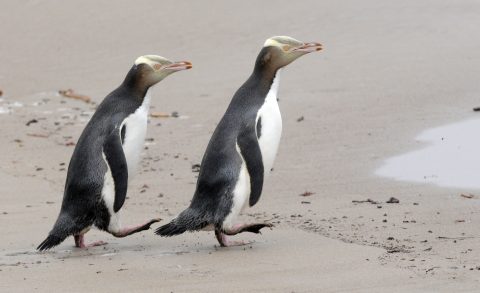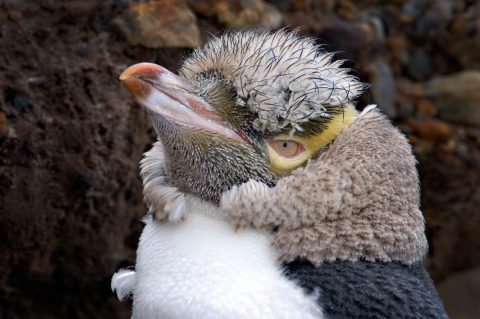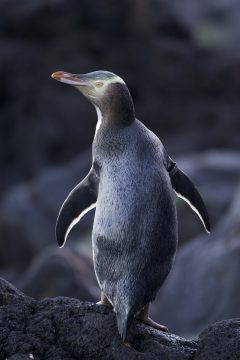Yellow-eyed penguins likely to be extinct on the mainland within my lifetime
The latest research on the likely fate of our dearly beloved yellow-eyed penguins is disturbing indeed. The study, from Thomas Mattern and colleagues at Otago University, shows that climate change is responsible for about a third of their population decline.
This means that most of the decline can be attributed to human factors such as fisheries interactions, predators, human disturbance and habitat degradation. Sadly we don’t have the data to back this up.

Photo: David Hallett
So why is that? Authorities have known for example, that yellow-eyed penguins get caught in set nets for more than 40 years; but still we don’t know how many are getting caught. Observer coverage on set nets was zero between 2002 – 2005 and now hovers just above zero, just enough so that we know penguins continue to be killed – for example two deaths were observed last year. Many more are likely to be killed but not reported.
Yellow-eyed penguin numbers have crashed in recent years, with just 216 breeding pairs left on the mainland. In some locations the declines are catastrophic. According to Mattern’s data, Boulder beach on Otago Peninsula where I lived until the late 1990s, recorded a 41 % decrease in breeding pairs over just 3 years from 2013 – 2015. I have treasured memories of the Otago Peninsula with yellow-eyed penguins standing proud on high sand-dunes surrounded by marram grass on wind swept beaches.
This sight is becoming increasingly rare, except perhaps on billboards at Auckland Airport. Mattern reminds us that yellow-eyed penguin and other ‘natural wonders‘ bring in over $100 million to the local annual economy every year. I used to run birdwatching tours through my company Kiwi Wildlife Tours around New Zealand. Dunedin was a highlight for our happy birdwatching clients taking in Northern Royal albatross, Otago and Foveaux shags, NZ sea lions, fur seals and of course penguins along with dramatic wild scenery and a host of other wildlife.

Moulting yellow-eyed penguin. Photo: Craig McKenzie
Unfortunately tourists themselves can be part of the problem for yellow-eyed penguins. Penguins are sensitive to disturbance around their nests and there are sites where uncontrolled tourism has been shown to be impacting breeding success. A recent Katiki Point Penguin Trust report showed that fledgling success was much lower where penguins had to cross tourist paths to get to their nests. Despite this DOC’s website directs visitors to this site to view yellow-eyed penguins. The phrase ‘killing the golden goose’ springs to mind.
The New Zealand government has just announced $76 million for DOC infrastructure – toilets, carparks, tracks and huts for tourists. But what about our wildlife? Our biodiversity is what makes New Zealand special. I’m reminded of the trailer I have just seen for the new Ridley Scott ‘Alien’ movie, filmed in magnificent Fiordland. The heroine announces to her team in hushed tones – “listen… nothing, no animal, no bird, there’s…nothing living”. How true that may yet turn out be. We risk selling empty promises to the millions of tourists flocking to New Zealand.
Where is the funding that will tackle the complex array of issues causing the decline of yellow-eyed penguins? What will be the whole of government approach to managing this impending disaster, as espoused by Conservation Minister Maggie Barry in her Threatened Species Strategy released last week?
I couldn’t agree more that this is what is required; DOC, MPI, Tourism NZ, iwi and regional councils need to collaborate on reversing the decline of yellow-eyed penguins. The causes of decline need to be met head-on. Difficult issues such as being killed in set nets can no longer be consigned to the ‘too hard basket’.

Photo: Luc Hoogenstein
I have suggested many times that MPI prepare a Yellow-eyed Penguin Action Plan and working group as we have for black petrels, another sea bird at high risk from fisheries interactions. DOC are working on putting together a Yellow-eyed Penguin Recovery Group. We should combine these two initiatives so that all decision-makers and funders are in the same room along with good science, iwi and NGOs such as Forest & Bird and the Yellow-eyed Penguin Trust.
The threat of climate change is just the kick in the guts we need to start acting. Thomas Mattern told me he thought yellow-eyed penguins could adapt but other human pressures are giving them little leg room to respond to climate change. If we are going to have yellow-eyed penguins as part of our mainland biodiversity we need to stop killing them now, and start saving them.
